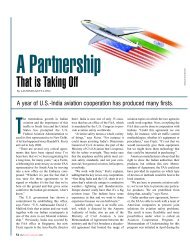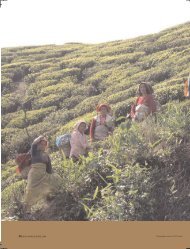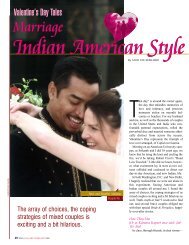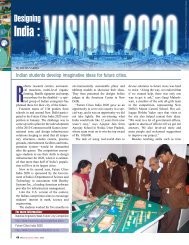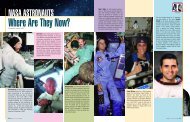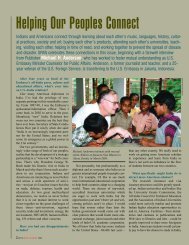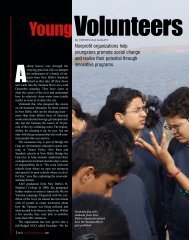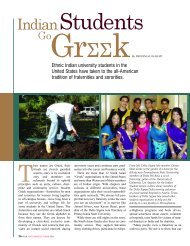Discovering New Horizons and Markets
Discovering New Horizons and Markets
Discovering New Horizons and Markets
Create successful ePaper yourself
Turn your PDF publications into a flip-book with our unique Google optimized e-Paper software.
Clockwise from far left: Globe Trekker host Ian Wright; a Discovery<br />
Travel & Living program; <strong>and</strong> a history show on the Sphinx.<br />
Sports. This distribution partnership substantially helped<br />
Discovery reach the present level of viewership, say channel<br />
officials.<br />
Animal Planet was launched in India in 1999, overlapping<br />
Discovery’s programs on wildlife. But Discovery officials say<br />
there is a difference. “Discovery presents real-world<br />
entertainment <strong>and</strong> covers genres like history, science, adventure,<br />
engineering, mystery, etc., while Animal Planet is completely<br />
dedicated to people’s fascination with animals,” explains<br />
Balasubramanian. The company plans to market Animal Planet<br />
aggressively this year.<br />
The latest member of the Discovery family in India is Travel<br />
& Living, which was launched in October 2004. It is aimed at<br />
the so-called global Indian. Its programming mix includes travel,<br />
cuisine, design, décor <strong>and</strong> fashion. The channel has<br />
commissioned two India-specific series, as viewer dem<strong>and</strong> for<br />
Indian content is rising, in India <strong>and</strong> abroad. The series—on<br />
Indian cities <strong>and</strong> food—will air this year.<br />
“Discovery has been a successful pioneer. National<br />
Geographic Channel <strong>and</strong> the History Channel which<br />
followed had the market opened for them by Discovery,”<br />
says Sevanti Ninan, media critic <strong>and</strong> editor of the media<br />
portal thehoot.org. “Its blend of Indianization <strong>and</strong><br />
mainstream international content has worked well, made<br />
non-fiction programming popular <strong>and</strong> created a formula that<br />
other international non-fiction channels can copy.”<br />
While the Hindi feed <strong>and</strong> local programming has helped<br />
Discovery attract new audiences, some feel that the channel at<br />
times reinforces stereotyped images of India with extensive<br />
coverage of tantrics, witches <strong>and</strong> the supernatural. The quality of<br />
Hindi translation—it is too literal—<strong>and</strong> the level of knowledge<br />
required to grasp science <strong>and</strong> technology programs also are<br />
points of criticism. “Their science <strong>and</strong> technology programs are<br />
excellent, but they are targeted more at elite audiences with a<br />
certain level of education <strong>and</strong> prior knowledge,” says Subodh<br />
Mahanti, a scientist with Vigyan Prasar, a science popularization<br />
arm of the government’s Department of Science <strong>and</strong> Technology.<br />
In fact, localization of content has been the cornerstone of<br />
success for satellite television in India as well as South Asia. As<br />
David Page <strong>and</strong> William Crawley pointed out in their book<br />
Satellites over South Asia: Broadcasting, Culture <strong>and</strong> the Public<br />
Interest: “The satellite revolution enables the international media<br />
to speak to the English-knowing middle class in one language<br />
<strong>and</strong> the greater Indian middle class in others. The fact that these<br />
audiences watch programs in different languages does not<br />
prevent them from being targeted with similar products <strong>and</strong><br />
lifestyles.” <br />
About the Author: Dinesh C. Sharma is a science <strong>and</strong> environment<br />
journalist based in <strong>New</strong> Delhi. He contributes regularly to<br />
<strong>New</strong>s.com (U.S.) <strong>and</strong> The Lancet (U.K.).<br />
A Peep into Indian Royalty<br />
I n<br />
the past 10 years, Discovery has aired several<br />
popular programs on themes ranging from<br />
Cleopatra’s palace to the inside of a space station.<br />
As far as India-related themes are concerned, the lives<br />
<strong>and</strong> tales of maharajas <strong>and</strong> royals continue to fascinate<br />
audiences. This can be gauged from the popularity of<br />
a program on the legendary Patiala necklace (above).<br />
It was an interesting tale of a necklace created by<br />
the house of Cartier for Maharaja Sir Bhupinder Singh<br />
of Patiala in 1928. It is supposed to be one of the most<br />
expensive pieces of jewelry ever made. The necklace<br />
is famous for its unmatched brilliance <strong>and</strong> extraordinary<br />
design. With five rows of platinum chains, it had<br />
2,930 diamonds embedded in it, including the world’s<br />
seventh largest DeBeers diamond. But this magnificent<br />
necklace disappeared around 1948 <strong>and</strong> was<br />
recovered by Cartier five decades later. The program<br />
revealed the story behind this piece of jewelry, with a<br />
backdrop of the colorful <strong>and</strong> romantic ambience of the<br />
royal families.<br />
The channel launched a new series on the maharaja<br />
of Jodhpur in late 2005. It portrayed the story of the<br />
Oxford-educated Maharaja Gaj Singh II, who is credited<br />
with pioneering the heritage hotel movement in<br />
Rajasthan <strong>and</strong> in India. Gaj Singh returned to India in<br />
1970, after the princely states had been derecognized<br />
<strong>and</strong> official support had ended. He faced adversity<br />
with dignity <strong>and</strong> reorganized his affairs <strong>and</strong> estates,<br />
while charting a new path through social <strong>and</strong> political<br />
realignments, commercial enterprise <strong>and</strong> the creation<br />
of charitable foundations <strong>and</strong> trusts. —D.C.S.<br />
SPAN JANUARY/FEBRUARY 2006 49





